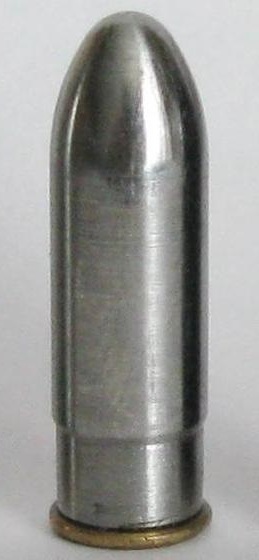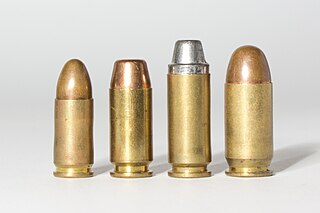Related Research Articles

A firearm is any type of gun that uses an explosive charge and is designed to be readily carried and operated by an individual. The term is legally defined further in different countries.

A cartridge, also known as a round, is a type of pre-assembled firearm ammunition packaging a projectile, a propellant substance and an ignition device (primer) within a metallic, paper, or plastic case that is precisely made to fit within the barrel chamber of a breechloading gun, for convenient transportation and handling during shooting. Although in popular usage the term "bullet" is often used to refer to a complete cartridge, the correct usage only refers to the projectile.

The .50 BMG, also known as 12.7×99mm NATO, and designated as the 50 Browning by the C.I.P., is a .50 in (12.7 mm) caliber cartridge developed for the M2 Browning heavy machine gun in the late 1910s, entering official service in 1921. Under STANAG 4383, it is a standard service cartridge for NATO forces. The cartridge itself has been made in many variants: multiple generations of regular ball, tracer, armor-piercing (AP), incendiary, and saboted sub-caliber penetrator rounds. The rounds intended for machine guns are made into a continuous ammunition belt using metallic links.

A rim-fire is a type of metallic cartridge used in firearms where the primer is located within a hollow circumferential rim protruding from the base of its casing. When fired, the gun's firing pin will strike and crush the rim against the edge of the barrel breech, sparking the primer compound within the rim, and in turn ignite the propellant within the case. Invented in 1845 by Louis-Nicolas Flobert, the first rimfire metallic cartridge was the .22 BB Cap cartridge, which consisted of a percussion cap with a bullet attached to the top. While many other different cartridge priming methods have been tried since the early 19th century, such as teat-fire and pinfire, only small caliber rimfire cartridges have survived to the present day with regular use. The .22 Long Rifle rimfire cartridge, introduced in 1887, is by far the most common ammunition found in the world today in terms of units manufactured and sold.

Caseless ammunition (CL), or caseless cartridge, is a configuration of weapon-cartridge that eliminates the cartridge case that typically holds the primer, propellant and projectile together as a unit. Instead, the propellant and primer are fitted to the projectile in another way so that a cartridge case is not needed, for example inside or outside the projectile depending on configuration.

The 9×19mm Parabellum is a rimless, centerfire, tapered firearms cartridge.

6.5×55mm Swedish, also known simply as 6.5×55mm, 6.5x55 SE, 6.5x55 Swede, or in its native military as 6.5 mm patron m/94, meaning "6.5 mm cartridge model 94", referring to 1894, is a first-generation smokeless powder rimless bottlenecked rifle cartridge. The cartridge has most users in the Scandinavian countries, where it is known as the 6,5×55 or just "the 6,5".

A headstamp is the markings on the bottom of a cartridge case designed for a firearm. It usually tells who manufactured the case. If it is a civilian case it often also tells the caliber: if it is military, the year of manufacture is often added.

Remington Rolling Block is a family of breech-loading rifles that was produced from the mid-1860s into the early 20th century by E. Remington and Sons.
The International Ammunition Association (IAA) is a nonprofit organization whose stated purpose is to foster interest and knowledge in ammunition of all types and forms.
The .260 Remington cartridge was introduced by Remington in 1997. Many wildcat cartridges based on the .308 Winchester case had existed for years before Remington standardized this round.

The Commission internationale permanente pour l'épreuve des armes à feu portatives, commonly abbreviated C.I.P., is an international organisation which sets standards for safety testing of firearms. As of 2015, its members are the national governments of 14 countries, of which 11 are European Union member states. The C.I.P. safeguards that all firearms and ammunition sold to civilian purchasers in member states are safe for the users.

The 9×25mm Mauser is a cartridge developed for the Mauser C96 service pistol around 1904 by DWM. Mauser pistols in this relatively powerful caliber were primarily intended for export to Africa, Asia, and South America. The 9mm Mauser Export cartridge was produced specifically for Mauser pistols and carbines made from 1904 to 1914 and then later from approximately 1930 to 1945 for submachine guns chambered for this caliber.

Ammunition is the material fired, scattered, dropped, or detonated from any weapon or weapon system. Ammunition is both expendable weapons and the component parts of other weapons that create the effect on a target.

The 6.5mm Remington Magnum is a .264 caliber (6.7 mm) belted bottlenecked cartridge introduced in 1966. The cartridge is based on a necked down .350 Remington Magnum which on turn is based on a shortened, necked down, blown out .375 H&H Magnum case. The cartridge was one of the first short magnum cartridges.

The .300 AAC Blackout, also known as 7.62×35 mm, is an intermediate cartridge developed in the United States by Advanced Armament Corporation (AAC) for use in the M4 carbine. The cartridge yields increased performance in shorter barrels and effective subsonic performance for silencer use when compared to 5.56 mm NATO. The .300 AAC Blackout uses standard 5.56 mm NATO magazines and components with the exception of the barrel.

The 7.92×33mm Kurz is a rimless bottlenecked intermediate rifle cartridge developed in Nazi Germany prior to and during World War II, specifically intended for development of the Sturmgewehr 44. The ammunition is also referred to as 7.9mm Kurz, 7.9 Kurz, 7.9mmK, or 8×33 Polte. The round was developed as a compromise between the longer 7.92×57mm full-power rifle cartridge and the 9×19mm Parabellum pistol cartridge.

Companhia Brasileira de Cartuchos (CBC) is a Brazilian ammunition and weapons factory based in Ribeirão Pires, São Paulo, Brazil.
The World Forum on Shooting Activities (WFSA) is an association of several national and international associations for shooters, hunters and arms collectors, as well as various arms trading and industry groups. WFSA is one of the few recognized non-governmental organizations to be invited to speak at all five United Nations Small Arms Conferences. The main objective of the association is to support scientific studies, preservation, promotion and protection of shooting related activities on all continents.

The German Experimental and Test Institute for Hunting and Sporting Firearms, usually shortened DEVA, is a German manufacturer's association whose purpose is to provide independent advice and testing for firearms and ammunition. DEVA conducts its work independently, and is co-owned by most German firearm manufacturers, such as Blaser, Heckler & Koch, Heym, Mauser, Merkel, Sauer, etc. DEVA today consists of two branches, one in Dune, Altenbeken and one on Stahnsdorfer Damm, Berlin.
References
- ↑ European Cartridge Research Association | UIA Yearbook Profile | Union of International Associations
- ↑ ECRA History - European Cartridge Research Association
- ↑ Ammunition Pages - Links
- ↑ ECRA - European Cartridge Research Association
- ↑ IAA Journal, (Issue 452, Nov/Dec 2006) p. 2
- ↑ European Cartridge Research Association – The Shooting SHED Journal
- ↑ Nøkkelopplysninger fra Enhetsregisteret - Brønnøysundregistrene
- ↑ Ecra Caliber Data Viewer - International Ammunition Association
- ↑ ECRA - European Cartridge Research Association
- ↑ Medea Corp Collectible Cartridges - Links of Interest
- ↑ Ecra Caliber Data Viewer - International Ammunition Association
- ↑ Asociación Argentina de Coleccionistas de Armas y Municiones (AACAM)
- ↑ Spolecnost pro studium Nabodju CZ / Slovensky klub zberatel'ov nabojov
- ↑ Nederlandse Vereninging voor Bestudering van Munitie en Ballistiek NVBMB
- ↑ Patronensammler-Vereinigung e.V.
- ↑ Gruppo Oplologico Italiano Di Riferimento
- ↑ New Zealand Cartridge Collectors Club (NZCCC)
- ↑ Scandinavian Ammunition Research Association (SARA)
- ↑ Scandinavian Ammunition Research Association
- ↑ Associação Portuguesa de Coleccionadores de Munições (APCM)
- ↑ Southern Africa Arms and Ammunition Collectors Association (SAAACA)
- ↑ Asociación Española de Coleccionistas de Cartuchos (AECC)
- ↑ Fachgruppe Schweizer Munition (FCHM)